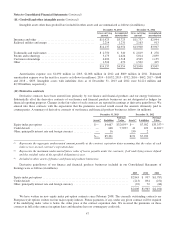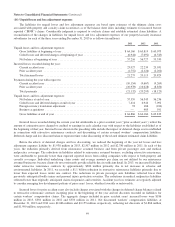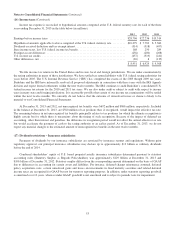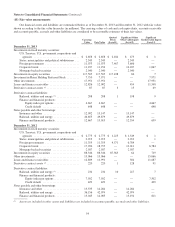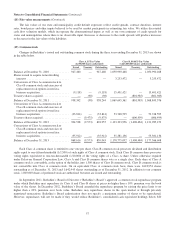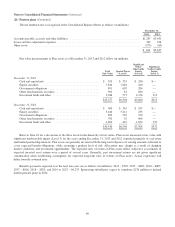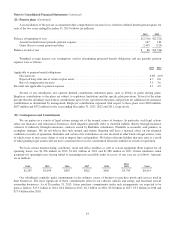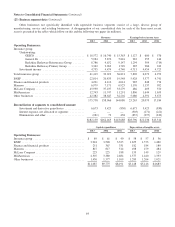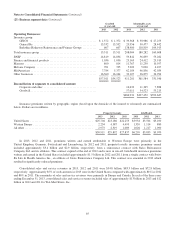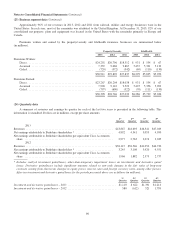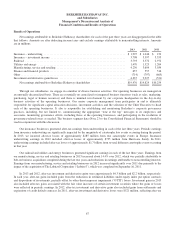Berkshire Hathaway 2013 Annual Report Download - page 59
Download and view the complete annual report
Please find page 59 of the 2013 Berkshire Hathaway annual report below. You can navigate through the pages in the report by either clicking on the pages listed below, or by using the keyword search tool below to find specific information within the annual report.
Notes to Consolidated Financial Statements (Continued)
(18) Fair value measurements (Continued)
The fair values of our state and municipality credit default exposures reflect credit spreads, contract durations, interest
rates, bond prices and other inputs believed to be used by market participants in estimating fair value. We utilize discounted
cash flow valuation models, which incorporate the aforementioned inputs as well as our own estimates of credit spreads for
states and municipalities where there is no observable input. Increases or decreases to the credit spreads will produce increases
or decreases in the fair values of the liabilities.
(19) Common stock
Changes in Berkshire’s issued and outstanding common stock during the three years ending December 31, 2013 are shown
in the table below.
Class A, $5 Par Value
(1,650,000 shares authorized)
Class B, $0.0033 Par Value
(3,225,000,000 shares authorized)
Issued Treasury Outstanding Issued Treasury Outstanding
Balance at December 31, 2010 ............. 947,460 — 947,460 1,050,990,468 — 1,050,990,468
Shares issued to acquire noncontrolling
interests ............................. — — — 3,253,472 — 3,253,472
Conversions of Class A common stock to
Class B common stock and exercises of
replacement stock options issued in a
business acquisition .................... (9,118) — (9,118) 15,401,421 — 15,401,421
Treasury shares acquired .................. — (98) (98) — (801,985) (801,985)
Balance at December 31, 2011 ............. 938,342 (98) 938,244 1,069,645,361 (801,985) 1,068,843,376
Conversions of Class A common stock to
Class B common stock and exercises of
replacement stock options issued in a
business acquisition .................... (33,814) — (33,814) 53,748,595 — 53,748,595
Treasury shares acquired .................. — (9,475) (9,475) — (606,499) (606,499)
Balance at December 31, 2012 ............. 904,528 (9,573) 894,955 1,123,393,956 (1,408,484) 1,121,985,472
Conversions of Class A common stock to
Class B common stock and exercises of
replacement stock options issued in a
business acquisition .................... (35,912) — (35,912) 55,381,136 — 55,381,136
Balance at December 31, 2013 ............. 868,616 (9,573) 859,043 1,178,775,092 (1,408,484) 1,177,366,608
Each Class A common share is entitled to one vote per share. Class B common stock possesses dividend and distribution
rights equal to one-fifteen-hundredth (1/1,500) of such rights of Class A common stock. Each Class B common share possesses
voting rights equivalent to one-ten-thousandth (1/10,000) of the voting rights of a Class A share. Unless otherwise required
under Delaware General Corporation Law, Class A and Class B common shares vote as a single class. Each share of Class A
common stock is convertible, at the option of the holder, into 1,500 shares of Class B common stock. Class B common stock is
not convertible into Class A common stock. On an equivalent Class A common stock basis, there were 1,643,954 shares
outstanding as of December 31, 2013 and 1,642,945 shares outstanding as of December 31, 2012. In addition to our common
stock, 1,000,000 shares of preferred stock are authorized, but none are issued and outstanding.
In September 2011, Berkshire’s Board of Directors (“Berkshire’s Board”) approved a common stock repurchase program
under which Berkshire may repurchase its Class A and Class B shares at prices no higher than a 10% premium over the book
value of the shares. In December 2012, Berkshire’s Board amended the repurchase program by raising the price limit to no
higher than a 20% premium over book value. Berkshire may repurchase shares in the open market or through privately
negotiated transactions. Berkshire’s Board authorization does not specify a maximum number of shares to be repurchased.
However, repurchases will not be made if they would reduce Berkshire’s consolidated cash equivalent holdings below $20
57


